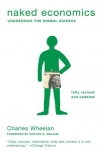Naked Economics Wheelan, Charles (books to read for 13 year olds TXT) 📖

Book online «Naked Economics Wheelan, Charles (books to read for 13 year olds TXT) 📖». Author Wheelan, Charles
Here is the strange thing: Official exchange rates—the rate at which you can actually trade one currency for another—deviate widely and for long stretches from what PPP would predict. If purchasing power parity makes economic sense, why is it often a poor predictor of exchange rates in practice? The answer lies in the crucial distinction between goods and services that are tradable, meaning that they can be traded internationally, and those that are not tradable, which are (logically enough) called nontradable. Televisions and cars are tradable goods; haircuts and child care are not.
In that light, let’s revisit our dollar-peso example. Suppose that at the official peso-dollar exchange rate, a Sony television costs half as much in Tijuana as it does in San Diego. A clever entrepreneur can swap dollars for pesos, buy cheap Sony televisions in Mexico, and then sell them for a profit back in the United States. If he did this on a big enough scale, the value of the peso would climb (and probably the price of televisions in Mexico), moving the official exchange rate in the direction that PPP predicts. Our clever entrepreneur would have a hard time doing the same thing with haircuts. Or trash removal. Or babysitting. Or rental housing. In a modern economy, more than three-quarters of goods and services are nontradable.
A typical basket of goods—the source of comparison for purchasing power parity—contains both tradable and nontradable goods. If the official exchange rate makes a nontradable good or service particularly cheap in some country (e.g., you can buy a meal in Mumbai for $5 that would cost $50 in Manhattan), there is nothing an entrepreneur can do to exploit this price difference—so it will persist.
Using the same Mumbai meal example, you should recognize why PPP is the most accurate mechanism for comparing incomes across countries. At official exchange rates, a Mumbai salary may look very low when converted to dollars, but because many nontradable goods and services are much less expensive in Mumbai than in the United States, a seemingly low salary may buy a much higher standard of living than the official exchange rate would suggest.
Currencies that buy more than PPP would predict are said to be “overvalued” currencies that buy less are “undervalued.” The Economist created a tongue-in-cheek tool called the Big Mac Index for evaluating official exchange rates relative to what PPP would predict. The McDonald’s Big Mac is sold around the world. It contains some tradable components (beef and the condiments) and lots of nontradables (local labor, rent, taxes, etc.). The Economist explains, “In the long run, countries’ exchange rates should move towards rates that would equalize the prices of an identical basket of goods and services. Our basket is a McDonald’s Big Mac, produced in 120 countries. The Big Mac PPP is the exchange rate that would leave hamburgers costing the same in America as elsewhere. Comparing these with actual rates signals if a currency is under-or overvalued.”3
In July 2009, a Big Mac cost an average of $3.57 in the United States and 12.5 renminbi in China, suggesting that $3.57 should be worth roughly 12.5 renminbi (and $1 worth 3.5 renminbi). But that was not even close to the official exchange rate. At the bank, $1 bought 6.83 renminbi—making the renminbi massively undervalued relative to what “burgernomics” would predict. (Conversely, the dollar is overvalued by the same measure.) This is not a freak occurrence; the Chinese government has promoted economic policies that rely heavily on a “cheap” currency. Of late, the value of the renminbi relative to the dollar has been a significant source of tension between the United States and China—a topic we’ll come back to later in this chapter.
Exchange rates can deviate quite sharply from what PPP would predict. That invites two additional questions: Why? And so what?
Let’s deal with the second question first. Imagine checking into your favorite hotel in Paris, only to discover that the rooms are nearly twice as expensive as they were when you last visited. When you protest to the manager, he replies that the room rates have not changed in several years. And he’s telling the truth. What has changed is the exchange rate between the euro and the dollar. The dollar has “weakened” or “depreciated” against the euro, meaning that each of your dollars buys fewer euros than it did the last time you were in France. (The euro, on the other hand, has “appreciated.”) To you, that makes the hotel more expensive. To someone visiting Paris from elsewhere in France, the hotel is the same price as it has always been. A change in the exchange rate makes foreign goods cheaper or more expensive, depending on the direction of the change.
That is the crucial point here. If the U.S. dollar is weak, meaning that it can be exchanged for fewer yen or euros than normal, then foreign goods become more expensive. What is true for the Paris hotel is also true for Gucci handbags and Toyota trucks. The price in euros or yen hasn’t changed, but that price costs Americans more dollars, which is what they care about.
At the same time, a weak dollar makes American goods less expensive for the rest of the world. Suppose Ford decides to price the Taurus at $25,000 in the United States and at the local currency equivalent (at official exchange rates) in foreign markets. If the euro has grown stronger relative to the dollar, meaning that every euro buys more dollars





Comments (0)